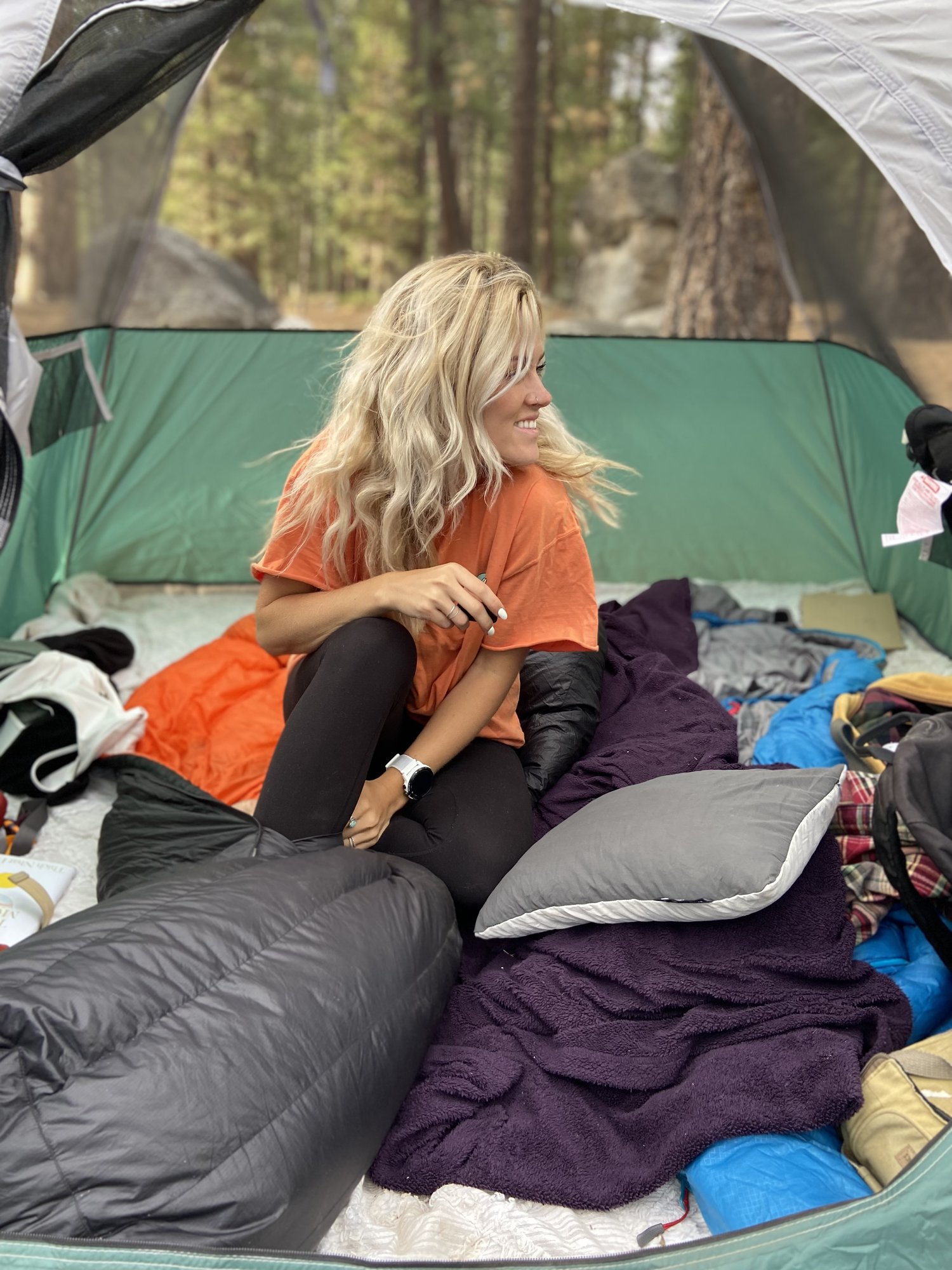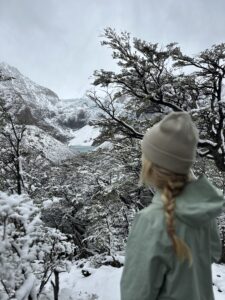The Best Camping Guide for Beginners and Solo Travelers
I’m so excited to share one of my favorite ways to adventure with you today!
I love car camping. It’s honestly a close second to backpacking for me. Car camping is for anyone and everyone who wants to spend more time outside. One of the reasons I love car camping is that I can make it as bougie as I want or keep things simple and go with the bare minimum.
Car camping doesn’t always mean sleeping in your car either—a tent 20 feet away is essentially the same.
Fun Fact: The term outdoors enthusiasts use for this is front country camping. Otherwise, you would be going backpacking in the backcountry, or on the other side of the spectrum, you would be considered #vanlife or RV camping.
Hey, I’m here for all of it, but it’s helpful to know a little about the differences. I’m always learning new outdoorsy lingo!
For this post, I will discuss sleeping inside your car or, if you are not far from your car, in a tent. Camping is the best way to fully immerse yourself in nature and spend the most amount of time possible enjoying being outside. You have the option to go to a campground and have a site with showers and bathrooms, or you could go on BLM land and find dispersed campsites, which usually have just a fire pit and maybe a picnic table.
Table of Contents

Picking Where You Want to Go Car Camping
I love prepping for camping trips. The research, packing, and journey are part of the fun! Here are my tried-and-true tips for making the most of your car camping trip.
Car Camping at Built-Up Front Country Campgrounds
For your first camping trip, I would suggest going to a real campground where you might have to pay $30, but you’ll have access to a bathroom and shower. Paid camping also gives you access to campground hosts who can help you find things to do in the area. Trust me, an investment of thirty bucks is worth every penny when it gives you access to a bathroom and a sense of security.
Research where you want to go and what you want to see. It may seem like an obvious step, but when you plan around the activities rather than just the location, you’ll have more time to dedicate to being outside rather than traveling a lot. For example, I love hiking and swimming, so I always prioritize finding campsites near mountains or by a lake. If you love picturesque small towns or fishing, look for places where you can pop in and out of small shops or chill by a lake.
A great place to start camping for the first time is a state park! They are often full of amenities, so even if you forget something, they’ll likely have a small convenience store with wood, ice, bug spray, etc. If you don’t have a state park nearby, look up KOA.com. They are all over the US and have great amenities as well.
Some places have their own website you can book on, but if you’re not sure where you want to go, I would recommend looking up different areas on Recreation.gov to pick a campground. HipCamp and The Dyrt are also good places to look for campsites; they are like Airbnb for camping but usually don’t have a lot of amenities.
Pro Tip: Bookmark Recreation.gov in your browser. It’s the central hub for all campground bookings, and I’m obsessed with it. You can also purchase the required permits you may need for the area.
Car Camping at Dispersed and Remote Campsites
Dispersed campsites are lots of land with designated campsites that don’t always have amenities. Sometimes, they have campfire pits, picnic tables, and at most, a volt toilet you share with everyone. These are often found in National Forests and on BLM land.
Pros of Camping at Dispersed Campsites
The pros of dispersed camping over campgrounds are that you usually have more privacy and don’t have to book a reservation, so you can change your plans and move to a new location. Dispersed camping often feels more wild and free, and that’s the feeling I love when I go camping. I often go back and forth between dispersed and paid camping on long trips so that every few days, I can shower and do laundry.
Potential Cons of Dispersed Campsites
They’re not as easy to find as a fully operating campground. There are a lot of options, especially out west, but you never know if they will be available when you arrive because you can’t reserve them. They’re first come, first served, and usually free. Many dispersed campsites are off dirt roads, and you should read as many reviews as possible before committing. For example, you need to know if your car will make it down the dirt road or if you need a 4WD vehicle. Getting stuck on one of these roads is not fun, especially with no cell reception.
Pro Tip: Search these sites for your next free/dispersed car camping adventure!
On long trips, I often switch between dispersed and paid campgrounds so that I can shower and do laundry every few days. KOA campgrounds often have both, haha.
Safety Tips for Solo Car Camping
Safety is the most important topic for us to discuss today. I want you to camp with these safety tips in mind and never underestimate your gut instincts.
Car Camping in Parking Lot and Pull-Offs Safety
If you’re sleeping inside your car in parking lots or pull-offs, you need to do your bedtime routine at a different gas station or grocery store before settling into your sleeping location. This minimizes your need to get out of your car. This rule is also essential when you’re road-tripping and need to pull over and sleep but can’t find a campground. Finding a pull-off to sleep in can be tricky because they aren’t always allowed. You do not want to sleep somewhere that could be dangerous, or you could get in trouble.
Here are a few places where you are generally allowed to sleep in your car overnight (these all depend on specific location rules and signs outside). (I am not saying they are all perfectly safe.)
- 24-hour Walmarts
- Casinos
- Large rest stops
- City street parking
- Cracker Barrel
Dispersed Sites and Campground Safety
Before you leave, never advertise on social media where you are going and if you’re going alone.
Do tell your family or close friends your exact plans and when you should be back.
Arrive at your campsite during the daylight to get a good grasp of your surroundings. I like to bring an extra chair to set up near my campfire and some men’s shoes or clothes to set out near my camp so people assume I’m not alone.
For self-defense, I sleep next to bear spray or a knife, and I always carry pepper spray when I’m going to the bathroom or for a hike. Make sure you know how to use all of those weapons before handling them. I try not to talk about being solo to strangers at camp unless I feel 100% comfortable with them. If something feels off from another camper bring it up to the park host or ranger immediately.
I make sure to bring a first aid kit in case of any emergencies
Know how to handle wildlife in the area. Most “real” campgrounds have an information booth on what wildlife is in the area and what to do. But if you are in a dispersed site you should do your research ahead of time. Extremely Important things to research are bear/moose safety, how to spot an animal with rabies, and all food storage tips. There’s a lot more, but knowing what animals are around you and how to react to those ones specifically is the best for trip safety prep.
Remember to relax and have fun!
Yes, we cover these things to prepare you but not to scare you. I have gone solo camping more than I could count, and I have never had a bad experience that required me to use any weapons or report any weird people.
Final Tip: Always trust your gut. If you feel like your camp neighbor is giving you weird vibes, leave or ask the ranger to move you to a different spot. If you’re not at a campground, pack up and move to a different dispersed area.
What Does ‘Leave No Trace’ Mean?
After you’re all set with your campsite and set up, it’s important to know how to treat the land you’re on. Leave No Trace principles are extremely important to implement into your new love for car camping. Dispersed campsites are only available if people care for and treat the land and its surroundings well. So, before you get into your camping weekend, here are some important LNT principles to check and uphold while you’re camping.
- Know your location. Does the land you are on need permits? Is there a fireman? Are you in a designated spot?
- Make sure you camp and drive on durable surfaces, not fresh vegetation.
- Make sure you don’t leave any trash behind(this means TP as well).
- Respect your neighbors(be mindful of how loud your music is).
- Respect and know what wildlife is in the area. For example, use bear canisters if needed and don’t approach wildlife.
- Leave the land the way you found it. Don’t collect rocks for your home or cut down trees for firewood.
- Minimize fire impacts, keep it small, and know how you will put it out. Every night, fully submerge your fire with water.
Before You Go
I hope this has been a helpful post for you as you prep for your planning your first car camping adventure!
Have fun, but remember to keep a safety-first mindset. Dont share on social media anywhere you are going until you have left. Always make sure to send your location to your friends or family so they know where you are and what your plans are.
Only camp in legal spots and respect the land by leaving no trace. Remember, you don’t need to have the trendiest gear to go camping! Use what you own and get started with your travels! As you camp, you’ll learn what you need and what you want to spend more money on.
As you camp, you’ll learn what you personally need and what you want to spend more money on.
Most importantly, have fun and be safe.
Check out my blog posts about camping for more tips! Are you new to backpacking? Check out my ebook Backpacking is for Everyone!
[Download the Checklist]








